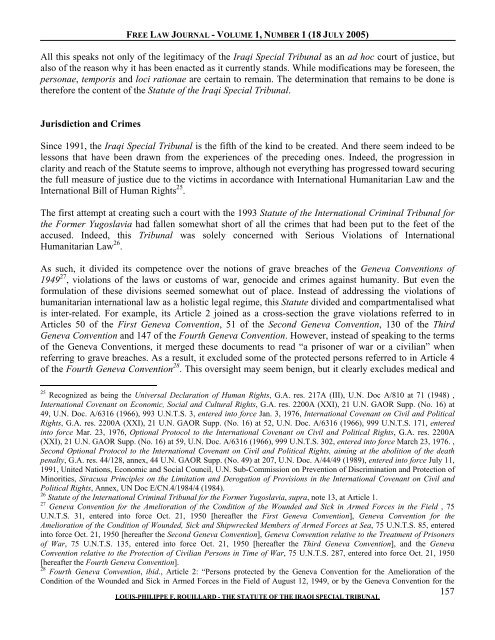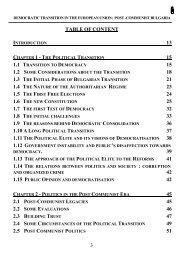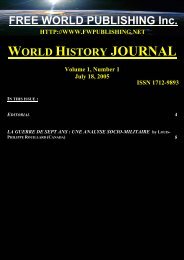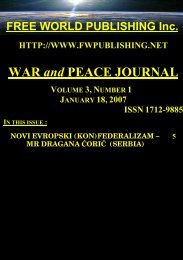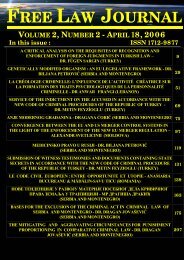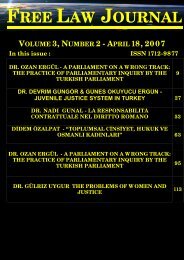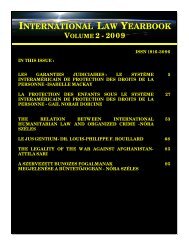Free_Law_Journal-Vol.. - Free World Publishing Inc.
Free_Law_Journal-Vol.. - Free World Publishing Inc.
Free_Law_Journal-Vol.. - Free World Publishing Inc.
You also want an ePaper? Increase the reach of your titles
YUMPU automatically turns print PDFs into web optimized ePapers that Google loves.
FREE LAW JOURNAL - VOLUME 1, NUMBER 1 (18 JULY 2005)<br />
All this speaks not only of the legitimacy of the Iraqi Special Tribunal as an ad hoc court of justice, but<br />
also of the reason why it has been enacted as it currently stands. While modifications may be foreseen, the<br />
personae, temporis and loci rationae are certain to remain. The determination that remains to be done is<br />
therefore the content of the Statute of the Iraqi Special Tribunal.<br />
Jurisdiction and Crimes<br />
Since 1991, the Iraqi Special Tribunal is the fifth of the kind to be created. And there seem indeed to be<br />
lessons that have been drawn from the experiences of the preceding ones. Indeed, the progression in<br />
clarity and reach of the Statute seems to improve, although not everything has progressed toward securing<br />
the full measure of justice due to the victims in accordance with International Humanitarian <strong>Law</strong> and the<br />
International Bill of Human Rights 25 .<br />
The first attempt at creating such a court with the 1993 Statute of the International Criminal Tribunal for<br />
the Former Yugoslavia had fallen somewhat short of all the crimes that had been put to the feet of the<br />
accused. Indeed, this Tribunal was solely concerned with Serious Violations of International<br />
Humanitarian <strong>Law</strong> 26 .<br />
As such, it divided its competence over the notions of grave breaches of the Geneva Conventions of<br />
1949 27 , violations of the laws or customs of war, genocide and crimes against humanity. But even the<br />
formulation of these divisions seemed somewhat out of place. Instead of addressing the violations of<br />
humanitarian international law as a holistic legal regime, this Statute divided and compartmentalised what<br />
is inter-related. For example, its Article 2 joined as a cross-section the grave violations referred to in<br />
Articles 50 of the First Geneva Convention, 51 of the Second Geneva Convention, 130 of the Third<br />
Geneva Convention and 147 of the Fourth Geneva Convention. However, instead of speaking to the terms<br />
of the Geneva Conventions, it merged these documents to read “a prisoner of war or a civilian” when<br />
referring to grave breaches. As a result, it excluded some of the protected persons referred to in Article 4<br />
of the Fourth Geneva Convention 28 . This oversight may seem benign, but it clearly excludes medical and<br />
25 Recognized as being the Universal Declaration of Human Rights, G.A. res. 217A (III), U.N. Doc A/810 at 71 (1948) ,<br />
International Covenant on Economic, Social and Cultural Rights, G.A. res. 2200A (XXI), 21 U.N. GAOR Supp. (No. 16) at<br />
49, U.N. Doc. A/6316 (1966), 993 U.N.T.S. 3, entered into force Jan. 3, 1976, International Covenant on Civil and Political<br />
Rights, G.A. res. 2200A (XXI), 21 U.N. GAOR Supp. (No. 16) at 52, U.N. Doc. A/6316 (1966), 999 U.N.T.S. 171, entered<br />
into force Mar. 23, 1976, Optional Protocol to the International Covenant on Civil and Political Rights, G.A. res. 2200A<br />
(XXI), 21 U.N. GAOR Supp. (No. 16) at 59, U.N. Doc. A/6316 (1966), 999 U.N.T.S. 302, entered into force March 23, 1976. ,<br />
Second Optional Protocol to the International Covenant on Civil and Political Rights, aiming at the abolition of the death<br />
penalty, G.A. res. 44/128, annex, 44 U.N. GAOR Supp. (No. 49) at 207, U.N. Doc. A/44/49 (1989), entered into force July 11,<br />
1991, United Nations, Economic and Social Council, U.N. Sub-Commission on Prevention of Discrimination and Protection of<br />
Minorities, Siracusa Principles on the Limitation and Derogation of Provisions in the International Covenant on Civil and<br />
Political Rights, Annex, UN Doc E/CN.4/1984/4 (1984).<br />
26 Statute of the International Criminal Tribunal for the Former Yugoslavia, supra, note 13, at Article 1.<br />
27 Geneva Convention for the Amelioration of the Condition of the Wounded and Sick in Armed Forces in the Field , 75<br />
U.N.T.S. 31, entered into force Oct. 21, 1950 [hereafter the First Geneva Convention], Geneva Convention for the<br />
Amelioration of the Condition of Wounded, Sick and Shipwrecked Members of Armed Forces at Sea, 75 U.N.T.S. 85, entered<br />
into force Oct. 21, 1950 [hereafter the Second Geneva Convention], Geneva Convention relative to the Treatment of Prisoners<br />
of War, 75 U.N.T.S. 135, entered into force Oct. 21, 1950 [hereafter the Third Geneva Convention], and the Geneva<br />
Convention relative to the Protection of Civilian Persons in Time of War, 75 U.N.T.S. 287, entered into force Oct. 21, 1950<br />
[hereafter the Fourth Geneva Convention].<br />
28 Fourth Geneva Convention, ibid., Article 2: “Persons protected by the Geneva Convention for the Amelioration of the<br />
Condition of the Wounded and Sick in Armed Forces in the Field of August 12, 1949, or by the Geneva Convention for the<br />
157<br />
LOUIS-PHILIPPE F. ROUILLARD - THE STATUTE OF THE IRAQI SPECIAL TRIBUNAL


